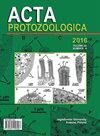生长速率调节使微生物真核生物在竞争排斥情景中共存
IF 1.2
4区 生物学
Q4 MICROBIOLOGY
引用次数: 1
摘要
共存通常超过竞争排斥原理的解释率。自先驱高斯以来,许多研究都使用原生微观系统来研究竞争排斥。我们探索了一个双物种系统,其中有两种变形虫:(Arcella intermedia和Pyxidicula operculata),其中竞争排斥预计会发生。我们分别测定了它们在竞争相互作用下的生长曲线。我们使用状态空间模型来表示系统动力学,并计算模拟竞争动态的后验种群大小。与我们的预期相反,Arcella和Pyxidicula的生长速度相似(分别为1.37和1.46天- 1),只是承载能力不同(分别为1,997和25,108个细胞cm-2)。在竞争中生长时,两种植物的最大细胞数都比单种培养低得多(平均而言,Arcella和Pyxidicula分别少73%和80%)。然而,我们的竞争实验总是以共存而告终。根据模型,增长率和随机性的下降主要解释了我们共存的结果。我们认为短暂资源的背景可以解释这些结果。此外,我们提出了产生随机性的因素,如种内变异、小种群效应、废物毒性和细菌群落的影响。本文章由计算机程序翻译,如有差异,请以英文原文为准。
Growth Rate Modulation Enables Coexistence in a Competitive Exclusion Scenario Between Microbial Eukaryotes
Coexistence usually are exceeding the explicable rate by competitive exclusion principle. Since the pioneer Gause, many studies have used protist microcosm systems to study competitive exclusion. We explored a two-species system with the testate-amoebae: (Arcella intermedia and Pyxidicula operculata), where competitive exclusion is expected to occur. We determined their growth curves individually and under competitive interaction. We used a state-space model to represent system dynamics and calculated posterior population sizes simulating competition dynamics. Contrarily to our expectation, Arcella and Pyxidicula showed similar growth rates (1.37 and 1.46 days–1 respectively) and only different carrying capacity (1,997 and 25,108 cells cm–2 respectively). The maximum number of cells of both species when growing in competition was much lower if compared to the monospecific cultures (in average, 73% and 80% less for Arcella and Pyxidicula respectively). However, our competition experiments always resulted in coexistence. According to the models, the drop in growth rates and stochasticity mainly explains our coexistence results. We propose that a context of ephemeral resources can explain these results. Additionally, we propose generating factors of stochasticity as intraspecific variation, small population effects, toxicity of waste products and influence of the bacterial community.
求助全文
通过发布文献求助,成功后即可免费获取论文全文。
去求助
来源期刊

Acta Protozoologica
生物-微生物学
CiteScore
2.00
自引率
0.00%
发文量
8
审稿时长
>12 weeks
期刊介绍:
Acta Protozoologica - International Journal on Protistology - is a quarterly journal that publishes current and comprehensive, experimental, and theoretical contributions across the breadth of protistology, and cell biology of Eukaryote microorganisms including: behaviour, biochemistry and molecular biology, development, ecology, genetics, parasitology, physiology, photobiology, systematics and phylogeny, and ultrastructure. It publishes original research reports, critical reviews of current research written by invited experts in the field, short communications, book reviews, and letters to the Editor.
 求助内容:
求助内容: 应助结果提醒方式:
应助结果提醒方式:


